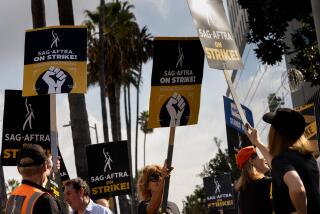SAG’s Internal Rift Hampers Strike Settlement
- Share via
Nearly six months into Hollywood’s longest strike, the Screen Actors Guild is beset by internal woes that are undermining efforts to settle its dispute with the advertising industry.
As the union and the smaller American Federation of Television and Radio Artists resume talks today in New York with advertising-industry negotiators, some SAG leaders now acknowledge that the union’s worst problems may well be found within its own walls.
A shift to a more militant leadership, a skeptical staff and conflicting agendas between hard-liners in the Los Angeles main office and the less confrontational AFTRA and New York membership are preventing a settlement. Adding to the disarray are the union’s bloated board, an underfunded war chest and a membership diluted in recent years by the swelling ranks of extras.
SAG’s inability to resolve this smaller, contained standoff makes a prolonged, widespread actors’ strike more likely next year when the studios and television networks negotiate new contracts.
The lengthy ad-industry strike has paralyzed the commercial-production community in Los Angeles, costing the local economy an estimated $125 million in direct lost production. It also has eroded Hollywood’s labor relations to their worst point in more than a decade.
“None of us had ever done this before,” said national strike coordinator and commercial actor Gordon Drake. “We’ve had to learn on the fly.”
The strike nearly ended last month, according to negotiators, when the two sides were within reach of an agreement on substantive financial issues. But talks imploded over a very small difference involving the size of an increase in pay for ads that run on cable TV and whether the actors’ contract should include jurisdiction over commercials made to run over the Internet.
By the union’s calculations, a paltry $18 million per year separates the actors from the advertisers over payments for ads that run on cable. The industry puts the amount at about $25 million.
Industry negotiator Ira Shepard expressed optimism that a deal can be reached soon. “We’re ready to end this thing, as long as we can get something that protects the industry economically,” he said.
Union’s Bloated Bureaucracy
The biggest issue for actors--a demand by the ad industry to pay them a flat fee for commercials that air on broadcast networks instead of the more lucrative residuals they now receive--was resolved when the ad industry dropped the idea in the last round of negotiations.
The union’s most intransigent problem is its unwieldy decision-making bureaucracy. SAG is governed by a staggering 105 board members, many of whom haven’t acted in years, according to union leaders. The board is the butt of jokes by other Hollywood union officials, who say its meetings are akin to a gathering of the United Nations. By contrast, the Writers Guild of America has 19 directors, while the Directors Guild of America’s board numbers 21.
This and other issues are addressed in a critical 4-inch-thick report by the Towers Perrin consulting firm. Union officials say the confidential report offers a blistering review of SAG’s operations, including the finding that SAG has far too many unnecessary offices across the country in places such as Portland, Cleveland and Detroit. The report also said SAG is so bogged down in overhead that covering the typical member costs more than three times the minimum $100 annual dues.
In a clear sign that the union wasn’t prepared for a prolonged strike, SAG took the labor action without a permanent war chest to help members cover their expenses while they are out of work. Though it is considered one of the basic requirements for any striking union, SAG allocated just $2 million from its treasury to aid strikers. Those funds eventually were supplemented with six-figure donations from such stars as Kevin Spacey, Helen Hunt, Harrison Ford, Nicolas Cage and Eddie Murphy.
“We’ve learned that in the future we have to have a strike fund so the industries take us seriously,” Drake said.
The union also didn’t anticipate the public apathy toward its strike. Officials now say the union should have made certain it at least lined up the support of the labor community before walking off the job. The union is working to patch up what have been historically poor relations with other Hollywood unions that resent SAG for failing to support them during disputes, SAG officials say.
The friction between the Los Angeles office and New York and AFTRA members was evident in the union’s floundering efforts to launch more hardball tactics to increase pressure on advertisers.
A just-launched boycott of advertising giant Procter & Gamble’s Tide, Crest and Ivory brands took more than five months to hatch despite repeated urgings from more militant Los Angeles members as well as a frustrated AFL-CIO, which had dispatched strike experts to advise SAG. But the strike-negotiating committee, where the Los Angeles members are outnumbered by AFTRA and New York members, balked repeatedly. The union’s more fervent Los Angeles leaders jokingly call themselves “the Branch Davidians”--after the religious sect whose members died resisting a 1993 government raid near Waco, Texas--and have dubbed their less-strident counterparts “the cavers” in reference to a perceived willingness to cave in to industry pressure.
“I proposed a boycott to the negotiating committee several times and each time it was turned down,” Drake said. “After 5 1/2 months, we’re finally waking up to the fact our members wanted to do a boycott.”
The spark that led to SAG’s transformation into a more confrontational union started in a casting office four years ago when Drake’s wife, veteran commercial actress Ruth Peebles, was commiserating with fellow actors on how they had to do more commercials to make the same amount of money.
When SAG’s last commercials contract was settled in 1997, Drake and a small band of others who believed the contract was insufficient organized a guerrilla campaign to oust the incumbent regime led by actor Richard Masur. Using e-mail chains and other methods to round up support for what they called the Performers Alliance, they succeeded in electing Willliam Daniels president last November. The Emmy winner who played Dr. Mark Craig on “St. Elsewhere” is an admitted labor novice.
“We need to learn from this,” Daniels said. “We need to look back when it’s over and figure out what was wrong, why we were not prepared and how to get prepared.”
Tensions Between Staff, Leaders
Despite winning the election, Los Angeles members have been hampered by union rules, some of which date back two decades, that give them just seven out of 26 slots on the strike-negotiating committee even though a majority of the commercial acting today is done in Los Angeles.
Not helping matters are tensions between SAG’s new leaders and its full-time staff led by longtime chief negotiator John McGuire, who were skeptical that a strike would be effective. The gulf between the two groups was evident from the first day of the strike when staff members remained upstairs in SAG’s Wilshire Boulevard offices rather than join strikers for a kickoff rally on the streets below. To this day, it remains a sore point with SAG’s leaders.
“There have been differences of opinion on how some things should be handled,” confirmed Chuck Sloan, a commercial actor and tax advisor who has emerged as Daniels’ closest consultant. But, he adds, “when decisions have been made, we’ve been united in pursuing our goals.”
Another source of conflict is that half of the 26 seats on the negotiating committee belong to AFTRA. The union is smaller and far less affected by the strike, representing such performers as actors who do radio spots. But SAG officials complain that rules nearly two decades old drafted when the two unions were considering merging gives AFTRA a 50-50 split with SAG on the seats.
Other seats on the negotiating committee belong to SAG officials in other cities, where actors can have much different needs. A chief concern among Los Angeles actors, who largely appear on camera, is the kind of overexposure that comes when ads run repeatedly on cable TV. Advertisers under the contract can run those ads over and over without making additional payments to actors, who argue that as a result they deserve more money.
By contrast, a large percentage--SAG estimates as many as two-thirds--of the New York commercial actors specialize in voice-over work. Because their faces don’t appear on camera, SAG says, being overexposed isn’t the critical problem it is in Los Angeles.
Although SAG has 98,000 active members total, the numbers don’t tell the whole story. As a rule of thumb, about 85% are typically unemployed and only about 5,000 work steadily in commercials.
That means huge numbers of members don’t work much at all, haven’t acted in years or have no firsthand experience doing commercials.
SAG’s numbers also include thousands of extras who appear sporadically in productions and have little in common with principal actors in TV shows, movies or commercials. Historically, extras, who prefer now to be called background actors, had their own union until the early 1990s, when SAG started representing them again. That swelled SAG’s ranks by thousands of members, shifting both the culture and internal politics of the union. It also opened the door for scores of extras to easily join the union.
“Actors despise extras because they aren’t artists. A lot of actors resent that they are in this union with people who aren’t artists but who are being protected by the union,” said University of Texas professor David Prindle, author of a history of SAG.
Once the strike ends, SAG will have to move fast to build on its two biggest accomplishments: keeping the union together despite the lengthy strike and the loss of more than $100 million in payments, and involving major stars including Tom Hanks, Julia Roberts and Paul Newman in the cause.
Big stars have historically avoided getting involved with SAG, in part because they command such high salaries and because SAG has only recently loosened rules prohibiting stars with production companies from joining its board. During the strike, many stars were so unfamiliar with the union that SAG staff members had to regularly send them maps so they could find its headquarters, next to the La Brea Tar Pits.
In large part, SAG owes whatever achievements it can claim to the ad industry’s stubbornness in withdrawing the “rollback” proposal that would have paid actors a flat fee for network ads rather than the residuals they get each time a commercial runs now. Early on, SAG leaders misread the proposal as a mere bargaining chip that would likely be withdrawn months before it was. When it remained, the proposal became a much-needed rallying point.
“It was a gift from the industry,” Drake said.
More to Read
The biggest entertainment stories
Get our big stories about Hollywood, film, television, music, arts, culture and more right in your inbox as soon as they publish.
You may occasionally receive promotional content from the Los Angeles Times.










